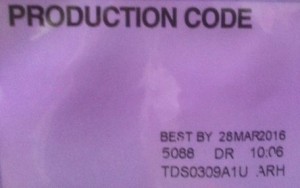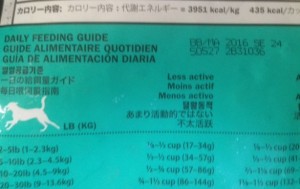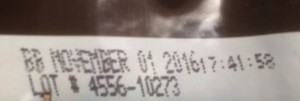Sometimes a bag is just a bag, a box is just a box, and a can is just a can. But when it comes to pet food, these containers are more than just vehicles to transport product from a manufacturer to your home. They are a critical source of information that may keep your pet safe.
We all know that important information is found on pet food packaging. Once we look past the pretty pictures and fancy slogans, we’ll find an Ingredient List to decipher, Guaranteed Analysis and nutrient charts, package weight, feeding guidelines, most likely an AFFCO seal of approval, and other bits of literature that are often overlooked.
One of those often overlooked pieces of information can tip us off to potential danger

Regardless of type, every package of pet food should carry a date of manufacture, an expiration date, or both. These seemingly random numbers can sometimes be the only clue revealing the difference between healthy and harmful pet food.
More often than not, a batch or lot number will accompany the date of manufacture. This tells us where and when that particular food was produced. Since some companies have more than one production plant, a batch or lot number is a critical pice of information during a recall.
This is why you should always keep your pet food package

It’s tempting to toss or recycle a pet food package as quickly as possible. For those of us who have food storage containers and feed kibble, it usually becomes second nature to get rid of the bag as soon as the contents have been transferred. But taking just a few extra seconds to clip those sometimes illegible digits are well worth the effort.
Many shops will not accept a return or exchange if you do not have the original packaging, or at least the date code of the product. Some also require the UPC code. But more importantly, retaining this information offers some assurance should you suspect a problem or if a recall is announced.
Without this information, you can’t tell whether your food has been affected

Even if you just suspect a problem, without this information there’s no practical way to follow up on it. Most recalls begin with a specific date code and/ or lot number. It’s not unusual for a recall to expand within a few days after it is first announced.
Armed with the production information from your food bag, you’ll be in a position to immediately know whether a recall affects you. By passing along this information, it may turn out that you become the first report of a pattern that leads to a recall or alerts a company to a potential problem.
These necessary numbers are can be hard to find

Sometimes your expiration date and lot number are clearly marked on the front or back of the bag. They can appear as stamped, printed or labeled characters.
Occasionally they get quickly stamped on a dark background making them difficult to find or read. Or light colored lettering may be printed on a white bag. Just finding the placement of these date codes can be a challenge.

Sometimes date codes appear as elongated letters and numbers which are practically illegible. Other times parts of a date or lot code may be missing.
Any of these issues can result from sloppy manufacturing practices which apply the numbers in haste during production. Even these seemimgly useless marks have value in the case of a recall or problem.
With recalls being issued monthly, it’s more important than ever to retain this information

When you’re about to pitch that next empty bag of food, remember there’s a small piece you may want to retain. When you’re still feeding food from that package, take the time to clip that date panel and stash it close to where you’ve put the food.
We wrote about this a couple of years ago, but the advice is worth repeating.
When a question arises, something just doesn’t seem quite right, or you hear about a recall, you’ll be very glad you kept that small piece of your package.

Thanks Craig!! Good to remember.
You’re welcome- glad it’s helpful!